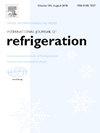汽车内饰热电封装空调的实验评价
IF 3.5
2区 工程技术
Q1 ENGINEERING, MECHANICAL
International Journal of Refrigeration-revue Internationale Du Froid
Pub Date : 2025-02-15
DOI:10.1016/j.ijrefrig.2025.02.009
引用次数: 0
摘要
许多研究人员正在为车辆开发空调。最新的空气冷却技术之一是热电包acr调节(TEPAC),其众多优点包括体积小,重量轻,能够处理直流电源。然而,本研究旨在评估两种模式(水/空气和空气/空气)TEPAC系统在50分钟测试周期下的有效性。实验研究了8个热电冷却(TEC)单元的TEPAC系统的冷却特性。提出了一种具有模拟汽车内部的原型室的TEPAC系统,以达到所需的24°C温度。测试了TEC输入电流、空气流量和水流量对冷却性能的影响。对两种TEPAC系统模式的综合性能系数(COPoverall)和电耗(EPC)进行了比较分析。总体而言,在所有研究案例中,水/空气TEPAC模式比空气/空气TEPAC模式更有效。结果表明,水/空气TEPAC模式的总cop2(18.2: 30%)高于空气/空气TEPAC模式,而水/空气模式的总EPC约比空气/空气模式大1.5 - 4.5%。水/空气TEPAC模式也证明了在50%占空比下使用脉冲宽度调制套件(PWMK)技术保持所需温度的灵活性。因此,水/空气TEPAC模式更有效地用于汽车内部空调。本文章由计算机程序翻译,如有差异,请以英文原文为准。
Experimental evaluation of the thermoelectric package air conditioning for an automotive interior application
Numerous researchers are developing air conditioning for vehicles. One of the newest techniques for air cooling is thermoelectric package acr conditioning (TEPAC), numerous benefits include its compact size, low weight, and ability to handle direct current sources. However, this study aims to evaluate the effectiveness of the two modes (water /air and air/air) TEPAC system under the 50 min test period. The cooling characteristics of the TEPAC system with eight thermoelectric cooling (TEC) units are experimentally presented. A TEPAC system with a prototype chamber to simulate the automotive interior is proposed to reach the desired temperature of 24 °C. The effects of TEC input electrical current, air flow rate and water flow rate on the cooling performance are measured. A comparative analysis of the overall coefficient of performance (COPoverall) and electrical power consumption (EPC) has been evaluated for two TEPAC system modes. The COPoverall the water/air TEPAC mode was more effective than the air/air TEPAC mode in all cases studied. It was found that water/air TEPAC mode generally had higher COPoverall (18.2: 30 %) than those of the air/air TEPAC mode, and the total EPC in water/air mode was found to be roughly 1.5–4.5 % greater than in air/air mode. The water/air TEPAC mode also proved flexible in maintaining the desired temperature with the pulse width modulation kit (PWMK) technique under % 50 duty cycle. Therefore, the water/air TEPAC mode is more effective for use in automotive interior air conditioning.
求助全文
通过发布文献求助,成功后即可免费获取论文全文。
去求助
来源期刊
CiteScore
7.30
自引率
12.80%
发文量
363
审稿时长
3.7 months
期刊介绍:
The International Journal of Refrigeration is published for the International Institute of Refrigeration (IIR) by Elsevier. It is essential reading for all those wishing to keep abreast of research and industrial news in refrigeration, air conditioning and associated fields. This is particularly important in these times of rapid introduction of alternative refrigerants and the emergence of new technology. The journal has published special issues on alternative refrigerants and novel topics in the field of boiling, condensation, heat pumps, food refrigeration, carbon dioxide, ammonia, hydrocarbons, magnetic refrigeration at room temperature, sorptive cooling, phase change materials and slurries, ejector technology, compressors, and solar cooling.
As well as original research papers the International Journal of Refrigeration also includes review articles, papers presented at IIR conferences, short reports and letters describing preliminary results and experimental details, and letters to the Editor on recent areas of discussion and controversy. Other features include forthcoming events, conference reports and book reviews.
Papers are published in either English or French with the IIR news section in both languages.

 求助内容:
求助内容: 应助结果提醒方式:
应助结果提醒方式:


